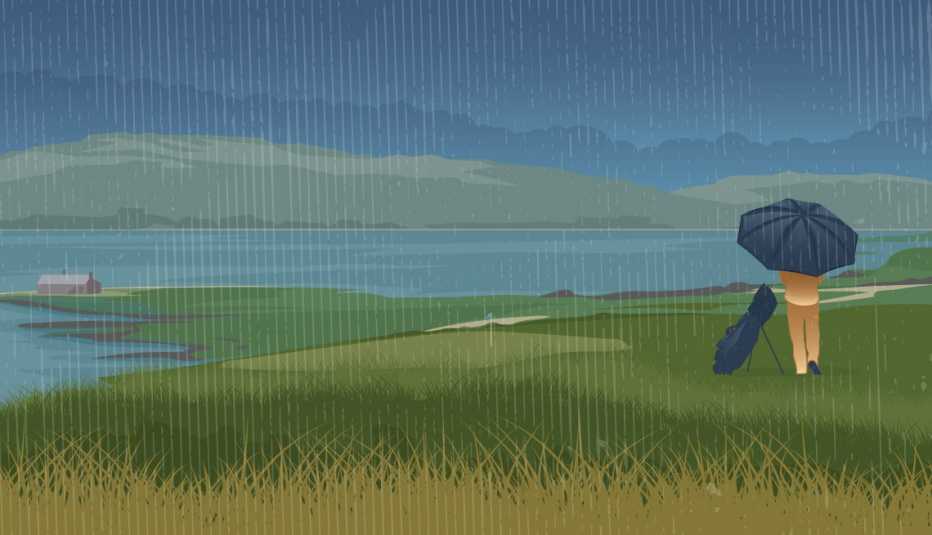Staying Fit


Wind slaps my cheeks and a light rain blurs my vision as I walk to the back tee of the par-three 10th hole at the Ardfin Estate golf course on Jura, a remote island in Scotland’s Inner Hebrides. Perched on a dramatic bluff jutting out above the ocean’s crashing waves, this cliff-to-cliff hero shot spans nearly 180 yards. I step up to the shot and am overtaken with the same sense of butterflies-in-my-stomach anticipation and nerves I experience when I go heli-skiing or surfing in big waves. However, unlike those extreme sports, the repercussions of a miscalculation have consequences only for the ball, not my body. And today I watch as the howling winds suck my ball straight down to be swallowed by the turbulent sea.
Golf is incredibly difficult, and as a type-A perfectionist, I typically avoid things I’m bad at. But someone once suggested I embrace activities that don’t come naturally to me. If I weren’t so focused on winning or performing well, I might have more fun, the friend rationalized. And if you start at the bottom, you can only improve, which means every attempt feels like a small achievement. I’ve discovered much truth in this sage advice, and have also come to realize it really is never too late to learn a new skill. Thus, when an opportunity arose to join a golf trip in Scotland, I said yes, even though I was a genuine novice. I’d played only Putt-Putt golf growing up on the New Jersey Shore and, as an adult, had played only once on a real course, in Hawaii — and didn’t even finish the round. But travel has sparked many of my passions (kitesurfing, road cycling), so I thought a new setting just might turn me on to this “gentleman’s game.”
I knew I risked offending an entire country by showing up to the home of golf without lessons and a basic understanding of golf etiquette. So two months ahead of the trip, I started meeting with an instructor one morning a week, then devoting weeknights to practicing alone the skills he’d taught me at a public driving range. The uniform-like golf outfits and resolute looks on the other golfers’ faces initially intimidated me. But every so often I’d catch glimpses of even the most professional-looking guys whiffing (swinging and missing the ball). Slowly I started to realize that proficiency at the sport takes practice and patience. Even lifelong golfers hit bad shots, so I told myself I shouldn’t be deterred.
Discovering linksland
Scotland is not a large country, but some of its greatest golf courses are on far-flung islands and isolated corners of craggy coastline, requiring hours of travel to reach. Given I only had one week’s time, I joined a trip with the logistics whizzes at Bravo Whisky Golf, which uses seaplanes and helicopters to efficiently whisk golf fans to otherwise hard-to-reach courses. A routine trip to Jura from Edinburgh, for example, would have required a full day of travel, including a ferry crossing. Via seaplane, we arrive in under one hour’s time, and our flight doubles as a stunning aerial tour of Scotland’s fissured coast, complete with castle and stag sightings.
Rule No. 1 of golf in Scotland: There’s no such thing as bad weather. I wake my first morning at Ardfin, an 18th-century estate turned modern hotel, to something the Scots call mizzle, a mix of mist and drizzle. The wind is wild. The air is cool and damp. There’s no chance we’ll golf in these conditions, I think. However, just as I light my fireplace and start to pull out a book, I hear a bang at my door. When I open it, I see the trip host smiling widely and holding a brolly (a Scotticism for umbrella) and rain gear. Turns out that most true Scotsmen play rain or shine.


































































You Might Also Like
A Writer’s Lesson: Don’t Wrestle With Words
Sometimes a note of imperfect poignancy works best
Through Travel Comes an Understanding of Your Family’s History
For a longtime writer, visiting homelands brings the pastMore Members Only Access
Watch documentaries and tutorials, take quizzes, read interviews and much more exclusively for members